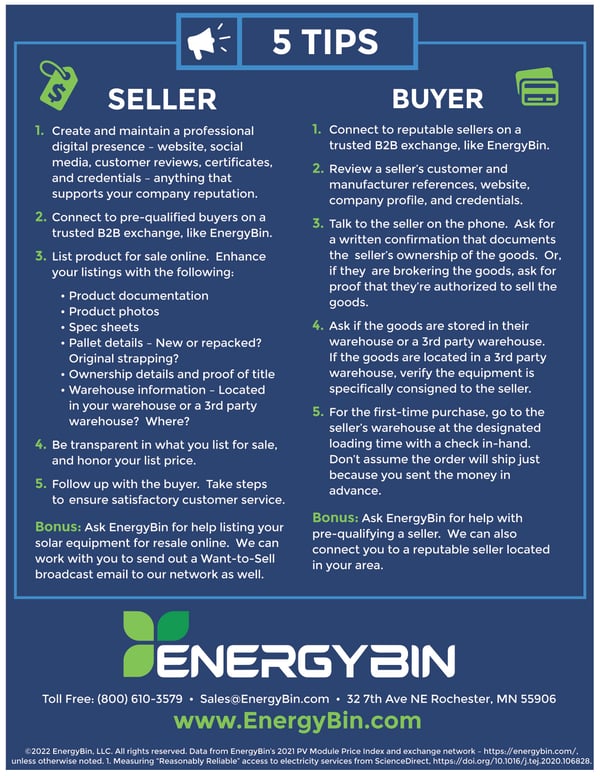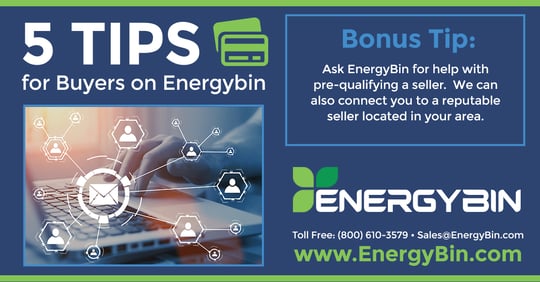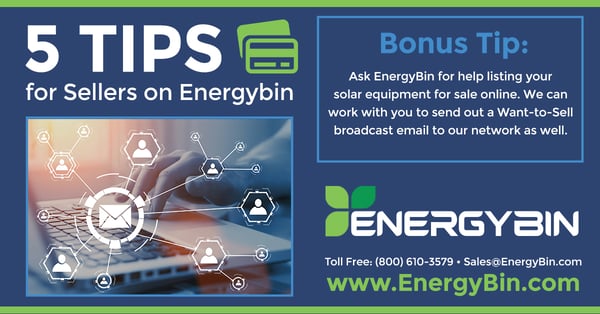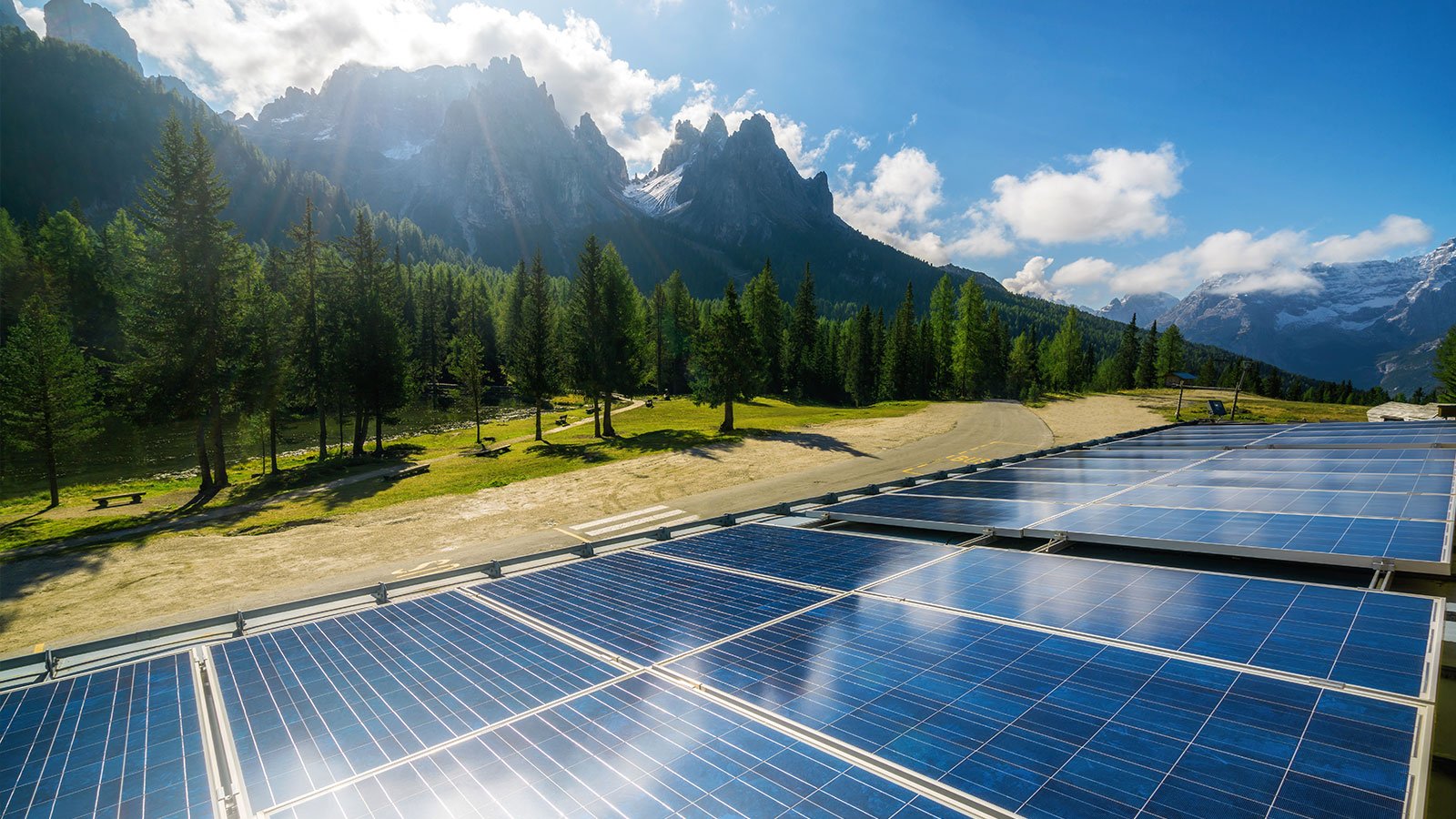The solar industry is fast-paced. Demand is booming, and supply often lags behind. Additionally, supply chain constraints create everyday challenges for those dealing in solar equipment. Yet, business goes on.
What can your company do to weather the ups and downs of prices and product availability?
How can you diversify your supply chain to minimize risk and meet your customers’ needs?
Where can you resell inventory that your primary customers aren’t buying?
The answers to these questions lie within the secondary solar market. Think of the secondary market as an alternative option for buying and selling solar modules, inverters, BOS material, batteries, etc. Further, it is a space where companies present value-added services, such as refurbishment and repair, 3rd party warranties, and solar equipment brokering.
Whether you’re a buyer, a seller, or both – yes, you may wear both hats from time to time – the secondary market offers a platform to generate new opportunities for your solar company.
This article outlines five need-to-know tips for buyers and five for sellers to incorporate into your secondary market strategy. They’re meant to position your company to successfully achieve your goals.

Buyers
Let’s start with buyers. These tips are intended for solar contractors, installers, EPCs, resellers, and brokers who are purchasing solar equipment at wholesale levels with the intention of reselling it. When seeking to expand your supply chain with new vendors, you minimize your risk and create opportunities to gain cost savings. You also increase access to product availability, which comes in handy when your primary vendors are back-logged or no longer carry a particular brand/model.
To ensure best results when dealing in the secondary market, exercise these tips.
1. Connect to reputable vendors on a trusted B2B exchange, like EnergyBin.
To protect yourself from risks such as counterfeit products, negligence, botched orders, etc., only do business with reputable vendors. We recommend using a B2B exchange over a marketplace for a few key reasons.
First, a trusted B2B exchange is comprised of your industry peers where members are vetted. For example, on EnergyBin, companies must provide references and proof of business registration before they can join the network.
Second, a trusted B2B exchange guarantees you gain access to wholesale pricing. Many online marketplaces are designed for business-to-consumer transactions, which means quoted prices are at retail levels.
Third, transactions take place between you, the buyer, and the seller, which allows you the freedom to build relationships with vendors. In contrast, seller information is usually not provided in an online marketplace context. You’ll see why this matters in the tips that follow.
2. Review a vendor's customer and manufacturer references, website, company profile, and credentials.
For new vendors who you’ve never worked with before, take the time to conduct your due diligence, which starts with this tip. Visit the company’s website. Look for customer reviews and manufacturer references. If you see a testimonial on the company’s website from one of your industry peers, call them and ask about their experience working with the vendor.
If you’re a member of an exchange or association, conduct a Company search for the vendor to view their profile (assuming they’re also a member). For example, EnergyBin members build company profiles on the exchange to include information about their specialties and value-added services, their credentials, and even certifications.
3. Talk to the seller on the phone.
Reach out to the company with your list of pre-qualifying questions. If you’re a member of a trusted exchange, personnel contact information is easily accessible from the company’s profile.
Because there are multiple types of sellers out there, you’ll want to question whether they’re a stocking or non-stocking seller. What that means is the seller will either assume ownership of the goods they represent for sale, or they will not. Whatever their business model is, verify that they have authorization to sell the products they represent. Ask for a written confirmation.
Here’s a list of additional interview questions you can use to qualify a seller:
- What products do they have available?
- What are the associated warranties per product?
- Do they require a minimum order?
- What is the turn-around time for delivery?
- What is the return policy?
- Do they offer financing options?
- What payment terms are available?
- What is their replacement policy for goods damaged during shipping?
- Do they offer drop-shipping?
- Do they have warehousing space available for lease?
- What other value-added services do they offer to their customers?
- Would they provide 2-3 references?
4. Ask if the goods are stored in their warehouse or a third-party warehouse.
If the goods are located in a third-party warehouse, verify the equipment is specifically consigned to the seller or that the seller is authorized by the third-party to represent the goods for sale.
Some sellers take additional steps to provide documentation up-front on their websites or company profiles. For example, we’ve seen many sellers attach photo documentation with product labels to their inventory listings on EnergyBin.
Additionally, EnergyBin requires every seller to ship products they list within 48 business hours unless clearly noted otherwise. If a seller fails to follow through, the EnergyBin Ethics Committee steps in to mediate the situation. These types of parameters all work together to protect buyers.
5. For your first-time purchase, go to the seller's warehouse.
When possible, go to the seller’s warehouse at the designated loading time. If you personally can’t go, send a proxy. We suggest you bring a check to drop off with the seller once you’ve verified the order is ready to ship. Don’t assume the order will ship just because you sent the money in advance. However, if the circumstances require advance-pay, we recommend you use an escrow service.
As stated in the previous tip, part of your membership to a trusted exchange adds protection by way of pre-qualifying members. On EnergyBin, every member is vetted as a legitimate solar company, and the Ethics Committee works to monitor and mediate buyer-seller relations among members.
Bonus Tip: Ask EnergyBin for help with pre-qualifying a seller. We can connect you to a reputable seller located in your area.
 Also, check out these resources for more advice on buying wholesale solar equipment:
Also, check out these resources for more advice on buying wholesale solar equipment:
- The Ultimate Guide to Buying Wholesale Solar Equipment
- Solar Equipment Resellers: Are they worthy of your business & where are the good ones?
- 5 Tips to Shop Wholesale Solar Equipment Online
Sellers
Moving onto sellers… These tips are intended for solar suppliers, distributors, resellers, and brokers who are selling PV equipment at wholesale levels. As a seller, you recognize the importance of expanding your reach as well as enhancing your customer experience. Ideally, you’d like buyers to be loyal customers indefinitely. But in reality, buyers come and go.
To gain new buyers and keep your current customers happy, follow these tips for best results.
1. Create and maintain a professional digital presence for your company and yourself.
The Internet provides plenty of options to develop an online presence. Create a professional website for your company, list your company in online directories, and create social media profiles. Include certifications, license numbers, trade association memberships, experience, third-party ratings and awards. You can also provide direct links to credential sources for buyers to easily verify your reputation.
As explained further in tip 2, join a trusted B2B exchange as a key part of enhancing your brand online. For example, EnergyBin provides every member a comprehensive company profile that members can view to learn more about what your company has to offer. Additionally, your company appears in search results when members search keywords you’ve included in your profile.
Further, consider the power of building your personal brand in alignment with your company brand. For example, you can leverage your personal social media profiles to promote your company and position yourself as an industry expert by commenting on solar-related posts, publishing thought-leadership content, and sharing your company’s social media posts to your social network.
2. Connect to pre-qualified buyers on a trusted B2B exchange, like EnergyBin.
To connect to new wholesale buyers, join a secure, trusted B2B exchange. We recommend using a B2B exchange over a marketplace for a few key reasons.
First, a trusted B2B exchange is comprised of your industry peers where members are vetted. For example, on EnergyBin, companies must provide references and proof of business registration before they can join the network.
Second, a trusted B2B exchange promotes liquidity and transparency, efficient pricing, product information sharing, and effective buyer-seller matches. Because the value lies in peer-to-peer connections rather than transactions, the cost per transaction is less than the typical online marketplace or auction site. For example, EnergyBin does not charge transaction fees as part of our commitment to supporting a robust and sustainable secondary solar market.
Third, you have a powerhouse of information at your fingertips. Information housed on exchanges include pricing, availability, quality, quantity, location, buyer/seller contact information, and so on. Having access to this information takes the guess-work out of doing business in the secondary market, thus allowing you to make informed decisions.
3. List your products for sale online.
Whether you list products in an open market or in an exclusive exchange, it’s imperative that you provide as much information as possible about the goods for sale. Your goal in creating online listings should be to give your buyer confidence in purchasing from you.
Enhance your listings with the following details:
- Production documentation
- Product photos
- Spec sheets
- Pallet details – New or repacked? Original packaging? Original strapping?
- Ownership details and proof of title
- If you are an agent for the owner of the goods, include documentation stating you have written authority to sell the goods.
- Warehouse information – Are the goods located in your warehouse or a 3rd party warehouse? Where?
- Minimum volume orders and/or volume discounts
Note that product certifications are necessary when listing on a global exchange, like EnergyBin, because you don’t want to mislead another member into thinking that a product is rated for the United States, for example, when it’s not. These details, along with those suggested above, help buyers to pre-qualify you as a vendor.
4. Be transparent in what you list for sale, and honor your list price.
There’s nothing more frustrating for a buyer than learning that a listed product for sale is not available, does not match the advertised condition, or varies in price from what is quoted. Strive for honesty and accuracy when listing your products for sale online.
If you sell the full or partial lot, update the listing as soon as possible. Also, keep an eye on your price. It’s perfectly acceptable to update prices online as market conditions change. But you don’t want to list a product for one price and then quote a higher price to the buyer. That goes against transparency.
The risk you run by withholding information or being elusive about the price is that you can quickly lose a buyer’s trust. In the solar industry, relationships bear weight. If it gets around that your company isn’t trustworthy, it could harm your reputation.
5. Follow up with the buyer.
Take steps to ensure satisfactory customer service. Wholesale buyers require your attention before, during, and after a purchase to feel good about doing business with you. Once they’ve determined you have the products they need at the price point their budgets allow, they’ll want to talk to you to verify you’re a reputable seller.
Belonging to a trusted exchange, like EnergyBin, makes it easy for buyers to pre-qualify you as well as to reach out to them. For example, by reviewing your uploaded inventory listings, you can see those members who’ve searched for and viewed your products. Calling or sending a personal email starts a conversation and gives buyers the opportunity to ask additional questions.
Stay in touch with them. Treat each prospect as a professional relationship from the get-go. Whether they become a buyer today, tomorrow, or a year from now, you want them to know you’re here to help with their solar equipment needs. Even if they never become your buyer, they may refer business to you. Treat them as you would want to be treated.
Bonus Tip: Ask EnergyBin for help listing your solar equipment for sale online. We can work with you to send out a Want-to-Sell broadcast email to our network as well.
 Also, check out these resources for more advice on selling wholesale solar equipment:
Also, check out these resources for more advice on selling wholesale solar equipment:
- The Ultimate Guide to Selling Wholesale Solar Equipment
- EnergyBin & Auctions: 2 Ways to Sell Surplus Solar Panels, Inverters, and Parts
- 5 Tips to Sell Wholesale Solar Equipment Online
Put your strategy into action
Make these tips work for you. By incorporating them into your secondary market strategy, you’ll diversify your supply chain, minimize the risks of sourcing and selling, and expand your PV solar professional network. After all, one of the key ingredients of a thriving, sustainable industry is the ability to connect, to come together.
It’s just as important to build relationships in the secondary market as it is in the primary market. When you’re connected, you can respond quickly to supply chain disruptions, you can fulfill customer needs, and you can leverage your company for new opportunities.
Now that’s a strategy you can’t pass up!
Contact us to learn more about how EnergyBin can help your company connect to wholesale buyers and sellers.
